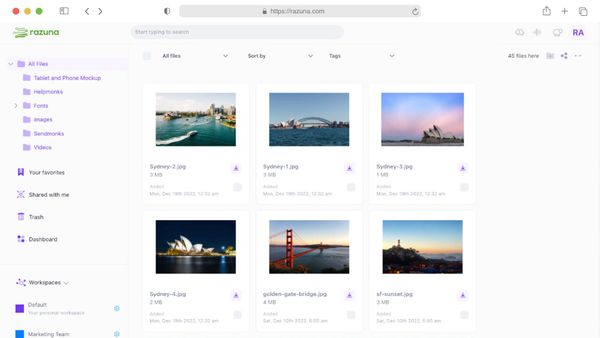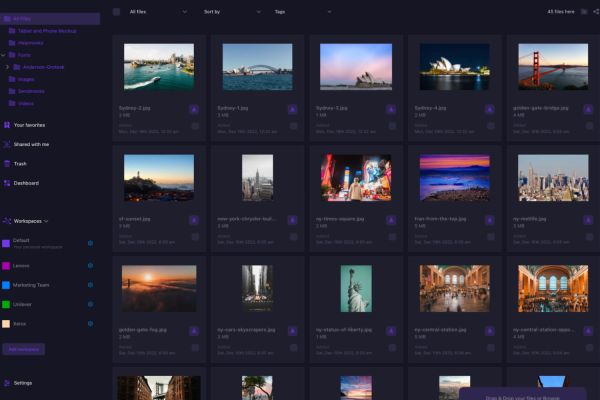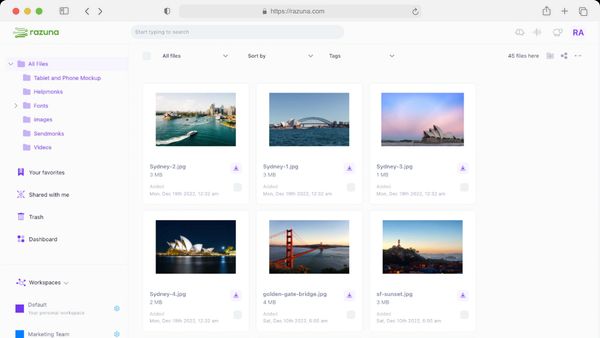
Announcing Collect+: Save and share everything
COLLECT+ is a productivity tool that helps you save and share everything you find on the web. It is built into the Razuna digital asset management platform.
Read nowEvery business leader knows the importance of defining and managing their unique brand. As a recognizable identity that represents their business values, it encourages employee unity and drives customer loyalty. That's why so much effort goes into brand definition and development.
Are you in the process of defining or redefining your brand? This is where authentic brand communications are crucial. Managing your brand is much easier when you understand the link between brand communication and your brand development strategy.
Keen to know more? Read this guide to effective brand development strategy, and soon you'll be mastering your brand communication.
Brand communication refers to all the messaging and interactions a brand has with its audience. Through brand communications, you reflect your brand's identity, values, mission, and offerings. It is the way you share your brand's story, positioning in the market, and messaging through your chosen touchpoints.
Brand communication includes brand marketing, public relations, customer service, brand design, and other touchpoints where your brand connects with its audience.
Effective brand communication is vital as it creates a strong and consistent brand image that resonates with your target audience. It will keep your brand at the top of your consumers' minds, fostering trust and loyalty and setting you apart from competitors.
These are the five key elements of brand communications, which all play an important role in your brand development strategy.
Your brand identity incorporates all the visible elements of your brand. What makes your brand instantly recognizable and identifiable? This includes your logo, imagery, as well as colors and design themes used in your logo and signage or product packaging.
Your brand messaging is the collection of practices you use to speak to the world. How do you communicate about your brand? Your slogan or catchphrase will be a part of your brand messaging. The tone of voice, language used, and core message all have to correlate with your company's values.
Your target audience is the group of potential new and existing consumers you wish to sell your products or services to. This group is further defined by certain demographics and behaviors that make them the ideal consumers for what you're selling.
Communication channels are the media platforms you use to market and promote your brand. It's where your brand and your audience connect. To have the desired impact, choose the communication channels that your target audience uses the most, and that best aligns with their interests.
Your content strategy uses creative content to achieve your branding, marketing, and other goals and objectives. All the planning, development, and management of your branding assets that this entails, form a part of your content strategy.

Brand communication is an integral part of your brand development strategy. Brand development provides the foundation for solid brand communication.
The way you communicate your brand's underlying message to your audience has a direct effect on the success of your brand development plan. Consistent and impactful brand communications contribute to the development of a strong and memorable brand.
While certain aspects of your marketing may change over time, your initial brand communications leave a lasting impression. This affects how successful your brand development will be.You must get it right from the start, with a strong brand communications plan that fosters engagement and loyalty.
When you have strong brand communications, you will enjoy several benefits, including:
Instant brand recognition is crucial for any company. The goal is to create a brand that is immediately recognizable, and easily distinguished from other brands.
These identifying characteristics will set you apart from your competitors, reducing consumer confusion. Strong brand communication enhances this recognition, so customers always know who you are and what you stand for, even from a brief glimpse at your marketing content.
Finding your audience is the first step of the brand management process. But what comes after that? Continued efforts to gain and build your customers' trust, that's what!
One of the top benefits of strong brand communication is that it improves customer trust. It does so through the real (or even perceived) addressing of customers' pain points and needs, or by mirroring their values.
Customer loyalty, or brand loyalty, is what keeps them coming back for more, and buying more. New customers are always great, but the objective is to retain those new customers.
Strong brand messaging helps to increase customer loyalty because people are instinctively loyal to what they find familiar. Create a familiar brand identity and channel this through all your brand communications, and you'll see your customer loyalty increase.
Your brand communication can also ensure a competitive advantage. The more recognition, trust, and loyalty you drive with your communications, the wider the gap between you and your competitors becomes.
Always strive to be authentic and consistent in your branding. This is what will set you apart from the rest. The need for stronger communications around your brand is understandably higher in the more competitive markets. But even niche markets with few competitors enjoy the advantages of strong brand communications.
You may be targeting a specific age group or cultural group. Perhaps you're targeting people with a specific hobby or interest, or certain values. Whatever the case, you'll do so more effectively when they feel you are speaking directly to them with your brand.
Communicating your brand strongly allows you to more effectively target your desired audience, by aligning with their values, norms, or interests. This is what builds the customer loyalty and trust that you are seeking for your brand.
Your efforts at targeting a particular audience will only be successful if you keep your brand identity consistent. Your brand identity is the first thing people see and recognize about your brand. It's responsible for showing your brand's personality to the world.
Avoid creating conflicting brand identities, or you'll be perceived as untrustworthy and unreliable. Strong brand communications that keep a consistent narrative going add to brand identity consistency.

Your communications are important in that they play a vital role in your overall brand development strategy. But how do you create a brand development strategy that best suits your business?
Here are our seven top tips for creating a brand development strategy that works for you.
Start by defining your brand identity. This step involves taking the essence of your brand's vision, mission, and values, and reflecting it in all your brand elements. These include your logo, color palette, design style, and brand voice and tone.
Be sure to choose colors and design elements that best represent your brand's core personality and message. Incorporate this into all your assets, including digital assets like advertising and marketing content.
You must create a seamless connection between your brand, its identifying elements, and your products. If you choose one that too closely resembles a competitor's brand, your customers won't be able to discern which products or services are yours.
The next step is to set your communication objectives. Start by defining your brand's development goals. Do you want to establish brand awareness, build trust and loyalty, or launch a new product/service? Your communication objectives should support these goals.
Next, create key messages that reflect your brand's essence and values. What do you want your communications to say about your brand? How do you wish to achieve this? Formulate a plan to meet these objectives, and decide on a timeline in which to achieve them. Your objectives should be SMART - specific, measurable, achievable, relevant, and time-bound.
If your KPIs show a decline in interest in your brand, you're not meeting your objectives. Your brand communication is the voice of your brand development strategy. Never become so distracted by making your voice heard, that you lose sight of what you want to say.
Customers are looking for authenticity and consistency, and your communications need to reflect this.
Your target audience likely encompasses different types of consumers. New products or services you launch will be better suited to some than others. Segmenting your target audience into subgroups allows you to deliver more targeted communications and marketing to the right customers.
To get audience segmentation right every time, get to know your audience. What are their most identifiable demographics? What have they purchased from you before? Have they engaged with your brand by signing up for a newsletter, or asked for information about a specific product?
Their levels of engagement thus far will give you valuable clues about their interests and spending power. This will help you to create more targeted and effective campaigns. Your consumers will tell you everything you need to know to communicate with them more effectively.
Brand positioning relates to positioning your brand in the minds (and hearts) of your customers. The means that you use to position your brand, may differ from one campaign to the next.
Brand positioning begins with knowing your competitors. From there, you can identify gaps in the market, and use a brand positioning map to insert your brand into the market. This will also help you define your Unique Selling Proposition (USP). Discover what differentiates your brand from your competitors, and take advantage of it in your messaging.
For example, you may want to position yourself as the most affordable, reliable, or trendiest brand among your competitors. Your positioning objectives may change over time, and this will influence the messaging you create to support it. Regardless of your positioning objectives, the method remains the same.
Your messaging should reflect the ideals that the position describes. If you're trying to position yourself as a brand synonymous with convenience, your messaging should reflect that, your video content should depict that, and your customer service should enforce it.
Next, consider which communications channels to use to create awareness of your brand. Begin by researching the different types of communication channels available. These include social media, content marketing, email marketing, public relations, traditional advertising, and more.
Determine which channels your target audience comes into contact with the most. Focus on the channels that are most likely to reach your target audience effectively and deliver the best ROI. In many cases, a multi-channel approach is most effective.
Tailor your content to suit each chosen communication channel. What works for a print ad might not work for social media - you'll have to adapt your content while sticking to the core concept of each campaign.
Developing a content strategy is vital to your brand development strategy. This entails consistent content creation as well as content collaboration and regular updating of your digital assets. This keeps your brand fresh and relevant to changing trends.
Stay organized by creating a content calendar outlining the types of content, publication schedule, and responsible team members. Focus on creating content that is fresh, relevant, valuable, and relevant for your target audience. Constantly update this calendar to reflect current industry trends and news.
However, don't get so caught up in producing new content that you lose sight of its intention. All new content must stay true to your brand.
Constantly monitor the performance of your communications and marketing materials. Adapt them when and if necessary. If you discover that your current communications and marketing are not hitting the right notes with your target audience, it's time to make some changes.
Potential customers love anything fresh and new that speaks to them. Existing customers love anything familiar that speaks to them. It's possible to do both, but it calls for constant evaluation and re-evaluation of your brand identity, communications, and marketing.
It's a lot easier to keep your brand development strategy on point with the right tools. Brand management tools that allow content collaboration, digital asset management, brand communications, and customer engagement are game-changers for your brand development strategy.
Brand communications are an essential element of any business' brand development strategy. But you need a brand management platform that takes your brand just as seriously as you do. Razuna will support your brand management every step of the way.
You can streamline your brand management today, without any complicated contracts or other hassles. That's why so many leading businesses trust our cloud-based brand management tools to manage their digital assets.
Are you ready to learn what our brand management tools can do for you? Register for a free account, and start mastering your brand communications today!

COLLECT+ is a productivity tool that helps you save and share everything you find on the web. It is built into the Razuna digital asset management platform.
Read now
These 18 tips for efficient photo organization are the best strategies for every marketer. Learn how to keep your digital images organized and accessible.
Read now
A digital asset library software organizes all digital assets in one place. But which one is the best? Here are the top 8 asset library software choices.
Read now
The latest update to our Digital Asset Management system, is focused on giving more power and flexibility to control user permissions, file, and folder access.
Read now
(each free accounts comes with 500 GB space)
